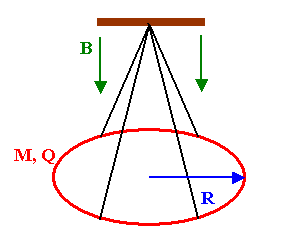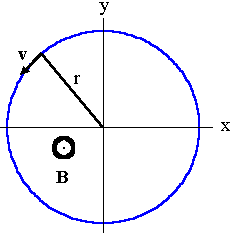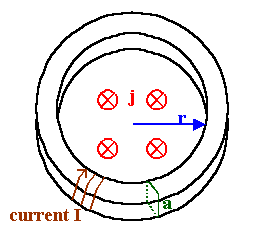Faraday's law
Problem:
A small circular search coil is used to search for stray magnetic fields
around a transformer. The coil diameter is 1.5 cm and its output is
connected to an ideal voltmeter. For a stray field of 1 mT at 60 Hz, how
many turns would be required for the search coil to produce a reading of 1 mV?

Solution:
- Concepts:
Faraday's law
- Reasoning:
The voltage in the coil is induced by a changing magnetic flux. The
magnetic flux changes with frequency f = 60 Hz.
- Details of the calculation:
ε = -∂F/∂t = induced emf,
F = ∫AB∙n dA, F ≈ BA = B0eiωtπR2N,
N = number of turns, when the face of the coil is perpendicular to the
direction of the magnetic field.
∂F/∂t = iωB0eiωtπR2N = -ε = V = V0ei(ωt+φ).
V0 = ωB0πR2N, N = V0/(ωB0πR2)
.
Vrms = V0/(√2) = 1 mV is the reading of the voltmeter.
N = √2*10-3V/(2π*60 s-1*10-3 T*π(7.5
10-3 m)2) = 21.
Problem:
(a) A coil has an inductance of 2 mH, and a current through
it changes from 0.2 A to 1.5 A in a time of 0.2 s. Find the magnitude of
the average induced emf in the coil during this time.
(b) A 25 turn circular coil of wire has a diameter of 1 m. It is
placed with its axis along the direction of the Earth's magnetic field
(magnitude 50 μT), and then, in 0.2 s, it is flipped 180o. What
is the average emf generated?
Solution:
- Concepts:
Faraday's law, induced emf
- Reasoning:
The magnetic flux through a coil is changing and we are asked to find the
induced emf.
- Details of the calculation:
(a) L = 2 mH, dI/dt = (1.5 - 0.2) A/0.2 s = 6.5 A/s.
ε = -LdI/dt = -(0.002 Vs/A)(6.5 A/s) =
-0.013 V.
The minus sign indicates that the induced emf opposes the flux changes that
produced it.
|ε| = 13 mV.
(b) ε = -dΦ/dt.
Φ = NAB = 25π(0.5 m)250*10-6 T
= 9.82*10-4 Tm2.
dΦ/dt = 2(9.82*10-4 Tm2)/(0.2 s)
= 9.82*10-3 V = 9.82 mV.
(The flux does not just drop to zero, it changes sign. This introduces
the factor of 2.)
Problem:
Clever farmers whose lands are crossed by large power lines have been known
to steal power by stringing wire near the power line and making use of the
induced current.
Suppose that the farmer places a rectangular loop with two sides of length a
parallel to the power line, the closest one at distance 5 m from it. The loop
and the power line lie in the same plane. Let the length of the sides
perpendicular to the power line be b = 0.5 m. The power line carries a 60 Hz
alternating current with a peak current of 10 kA.
(a) If the farmer wants a peak voltage of 170 V (which is the peak of
standard 120 V AC power) what should be the length a?
(b) If the equipment the farmer connects to the loop has a resistance R =
5 Ω, what is the farmer's average power consumption?
(c) If the power company charges 10 cents per kWh, what is the monetary
value of the energy stolen each day?
(Give a numerical answer!)
Solution:
- Concepts:
Faraday's law
- Reasoning:
The magnetic flux through a loop is changing with time. This flux
change induces an emf. The emf causes a current to flow, which
dissipates energy.
- Details of the calculation:
(a) Ampere's law: B = μ0I/(2πr), B encircles the
power line.
Flux of B through the rectangular loop: F = a[μ0I/(2π)] ∫5m5.5mdr/r
= a[μ0I/(2π)]ln(5.5/5).
emf = -dF/dt = -a[μ0/(2π)](dI/dt)ln(5.5/5).
Peak emf = a[μ0/(2π)](2π*60/s*104
A)ln(5.5/5) = a*0.072 V/m.
For a peak emf of 170 V we need a = 2.37 km.
(b) P = V2rms/R = (120 V)2/(5 Ω) =
2.88 kW.
(c) 2.88 kW *24 h = 69.12 kWh. The monetary value is $6.91 per
day.
Problem:
A non-conducting ring of mass M, radius R, and total charge
Q uniformly distributed around the ring hangs horizontally, suspended by
non-conducting thin ("massless") strings as shown.

A uniformly increasing magnetic field B = B0t
pointing down is turned on at time t = 0.
(a) Find the torque on the ring in terms of B0, M, R, and Q.
(b)
If the strings supporting the ring provide a torque -αφ,
where φ is the angle through which the
ring turns, write the equation of motion in terms of B0, M, R, Q and
α.
Solution:
- Concepts:
Faraday's law
- Reasoning:
A changing magnetic flux through a ring induces an emf. The resulting
electric field exerts a force on the charge Q on the ring. This force
produces a torque about the center of the ring.
- Details of the calculation:
(a) The emf induced in the ring is
∮Γ E∙dr = -∂/∂t∫AB∙n
dA = -πR2∂B/∂t = -πR2B0.
The magnitude of the induced electric field is therefore
given by
2πRE = πR2B0,
E = RB0/2.
The direction
of E is tangential, counterclockwise for increasing
B.
The torque on the ring τ
= QRE = QR2B0/2 in the vertical direction.
(b) Total torque τtotal
= Id2φ/dt2 = MR2
d2φ/dt2 = QR2B0/2
- αφ, where we measure φ
ccw from the equilibrium position.
Equation of motion:
d2φ/dt2
= QB0/(2M) - αφ/( MR2).
Resulting motion:
Harmonic oscillation about a position φ0 = QR2B0/(2α)
with angular frequency ω = (α/( MR2))½.
Problem:
An electron accelerator employs a time varying magnetic flux through a plane
circular loop of radius R = 0.85 m, and the electrons always move in this
circular path with this radius. The magnetic induction in the loop plane
B(r) = B0 - Kr2, r < R;
B = 0, r > R,
is everywhere normal to the loop plane with r the distance from the
loop center.
(a) Show that, at any instant, the average magnetic induction in the
loop Bav, must be related to BR by Bav = 2BR. Evaluate K.
(b) B0 increases linearly from 0 to 1.2 Tesla in 5.3 sec.
Deduce the energy gain per turn for the electrons and the maximum electron
energy achieved.
Solution:
- Concepts:
Faraday's law, induced emf, motion in a circular orbit at relativistic
speeds
- Reasoning:
The changing magnetic flux through a circular loop induces an emf. The
resulting electric field is tangential to the loop and accelerates the
electron. A light electron soon reaches relativistic speed.
- Details of the calculation:
(a) You can show part (a) using relativistic or non-relativistic
equations.
For an electron in a circular orbit lying in the x-y plane
perpendicular to the magnetic field B = Bk and centered at the
origin we have
F = -qev ×
B(R) = -qevB(R)(r/r)
(SI units).
For a particle in a circular orbit the centripetal force is
F = -(γmv2/R)(r/r).

[Assume a particle moving in a circular orbit of radius
r with constant speed v.
x = rsinωt, y = -rcosωt,
vx =
ωrcosωt,
vy = ωrsinωt,
px =
γmωrcosωt,
py = γmωrsinωt,
Fx = dpx/dt = -γmω2rcosωt
= -γmω2x,
Fy = dpy/dt = γmω2rcosωt
= -γmω2y.
F = -γmω2r
= -(γmv2/r2)r.]
We therefore have qevB(R) =
γmv2/R
= pv/R, B(R) = p/(qeR).
|ε| =
|∂F/∂t|
is the magnitude of the induced emf. Assume B is increasing with time.
2πRE =
∂(BavgπR2)/∂t,
E = (R/2)dBavg/dt.
The magnitude of the tangential force accelerating the electron is
Ft
= qeE = (qeR/2)dBavg/dt.
So we have dp/dt = (qeR/2)dBavg/dt, and dp/dt = (qeR)dB(R)/dt.
½dBavg/dt = dB(R)/dt,
ΔBavg/2
= ΔB(R).
If we start with B = 0 we have Bavg = 2B(R).
B(r) = B0
- Kr2, r < R,
πR2Bavg = 2π∫(B0
- Kr2)rdr with integration limits 0 and R.
Bavg = B0
- KR2/2, B(R) = B0 - KR2, B0
- KR2/2 = 2(B0 - KR2),
B0 = (3/2)KR2,
K = (2/3)B0/R2.
B(r) = B0(1 - (2/3)r2/R2).
(b) |ε| = ∂(BavgπR2)/∂t
= (2πR2/3)dB0/dt = energy
gain per unit charge per revolution.
qe|ε| = energy gain of an electron
per revolution.
dB0/dt = (1.2 T)/(5.3 s), qe|ε| =
5.48*10-20 J.
To find the total energy gained we note:
F = dp/dt = qeE = constant. p = qeEt. Energy
= (p2c2 + m2c4)½.
E = (R/2)dBavg/dt = (2/3)(R/2)dB0/dt = (R/3)dB0/dt.
p = qe(R/3)(1.2 T/5.3 s)t. After 5.3 s p = qe(R/3)1.2 T
= 5.44*10-20 kgm/s.
Energy = ((5.44*10-20 kgm/s)2c2 *(1 MeV/1.6*10-13
J)2
+ (0.511 MeV )2)½ = 102 MeV.
Energy gained: 102 MeV - 0.511 MeV.
Problem:
A spatially uniform current density j =
j0
cosωt flows through the hole of a torus
along the axis of the torus as shown. The
inner radius of the torus is r, and the cross section is square with sides a (a
<< r). The torus is made of
an insulating material with m = μ0.
A wire of resistance R wraps around the torus with a total of N turns.
Determine the current flowing in the wire.

Solution:
- Concepts:
Ampere's law, Faraday's law
- Reasoning:
Amperes law,
∮Γ B∙ds = μIthrough_Γ
yields B inside the torus. Since the flux of B through the wire loops
surrounding the torus is changing, an emf is induced in the wire loops and a
current flows.
Assume R is large and neglect the self-inductance of the loops.
- Details of the calculation:
B inside the torus is tangential
(clockwise for j pointing into the
paper),
2πrB(r) = μ0
j0 cosωt
πr2,
B(r) = μ0 j0
cosωt r/2.
Since a << r, we assume that B is approximately constant inside the
torus.
(Note: r here is not a
variable, but the radius of the torus.)
The flux of B through one loop of the wire is B(r)a2.
The total flux through the N loops is NB(r)a2.
The emf induced in the wire is
∮Γ E∙dr = -∂/∂t∫AB∙n
dA = -Na2∂B/∂t.
We have V = Na2 μ0
ω j0 sinωt
r/2.
I = V/R = Na2 μ0
ω j0 sinωt
r/(2R).

Problem:
A loop of wire of resistance R and a coil of
self-inductance L encloses an area A. A spatially uniform magnetic field is
applied perpendicular to the plane of the loop with the following time
dependence:
For t < 0 the field is zero, for 0 < t < t0 B(t)
= kt, for t > t0 the field remains constant at B0 = kt0.
(a) Calculate the current I in the loop for all times t > 0, given that I = 0
for t = 0.
(b) Make simple sketches of the current vs. time for t0
< L/R and t0 > L/R..

Solution:
- Concepts:
Faraday's law, Lentz's rule
- Reasoning:
The magnetic flux through a filamentary loop is changing with time. This
flux change induces an emf.
- Details of the calculation:
(a) Flux Φ = BA = ktA for t < t0,
Φ = BA = kt0A for t > t0.
emf = -dΦ/dt = -kA for t < t0,
Φ = BA = 0 for t > t0.
The resulting current flows in the clockwise direction.
For t < t0: IR + LdI/dt = kA, dI/dt = kA/L - IR/L,
Try I = a - bexp(-ct), Then a = kA/R, c = R/L, I = 0 at t = 0 yields b =
kA/R,
I(t) = (kA/R)(1 - exp(-Rt/L)).
For t > t0: dI/dt = -IR/L, I(t) = I(t0)exp(-R(t
- t0)/L)
(b)

Problem:
A square
loop with side b is made of a wire of mass m and negligible electric resistance.
The loop has a gap which can be closed with a switch. Initially the switch is
open. The loop is pivoted along its top horizontal side and placed in the
weak vertical uniform magnetic field B as shown. The loop is then pulled to
a horizontal position, the switch is closed and the loop is released.
Eventually, the loop comes to rest due to air resistance. Find the angle θ
that the plane of the loop makes with the vertical at the final position. The
self inductance of the loop is L.

Solution:
- Concepts:
Induced emf, quasi-static situations
- Reasoning:
The wire has no resistance. The flux of B through the loop is
constant. Any change in the flux of the external field through the loop is
immediately canceled by the change in the flux
F = LI due to a induced current in the loop.
We therefore have Bb2 = Bb2sinθ + LI.
(initial flux = final flux)
- Details of the calculation:
In equilibrium the gravitational torque must cancel the torque on the
current loop in the magnetic field.
Magnitude of gravitational torque about pivot line:
(m/4)g b sinθ
+ 2(m/4)g (b/2) sinθ =
½ b mg sinθ.
Magnitude of magnetic torque about pivot line:
Ib2B
cosθ.
We need:
½ b mg sinθ = Ib2B
cosθ.
We have two equations for two unknowns, I and θ,
I = (Bb2/L)(1 - sinθ) and tanθ = 2IbB/(mg).
Combining these equations we obtain
tanθ
= C(1 - sinθ), with
C = 2b3B2/(mgL).
Since the field is weak,
θ << 1, tanθ ~ sinθ
~ θ,
θ = C(1 - θ),
θ
= C/(1 + C).








